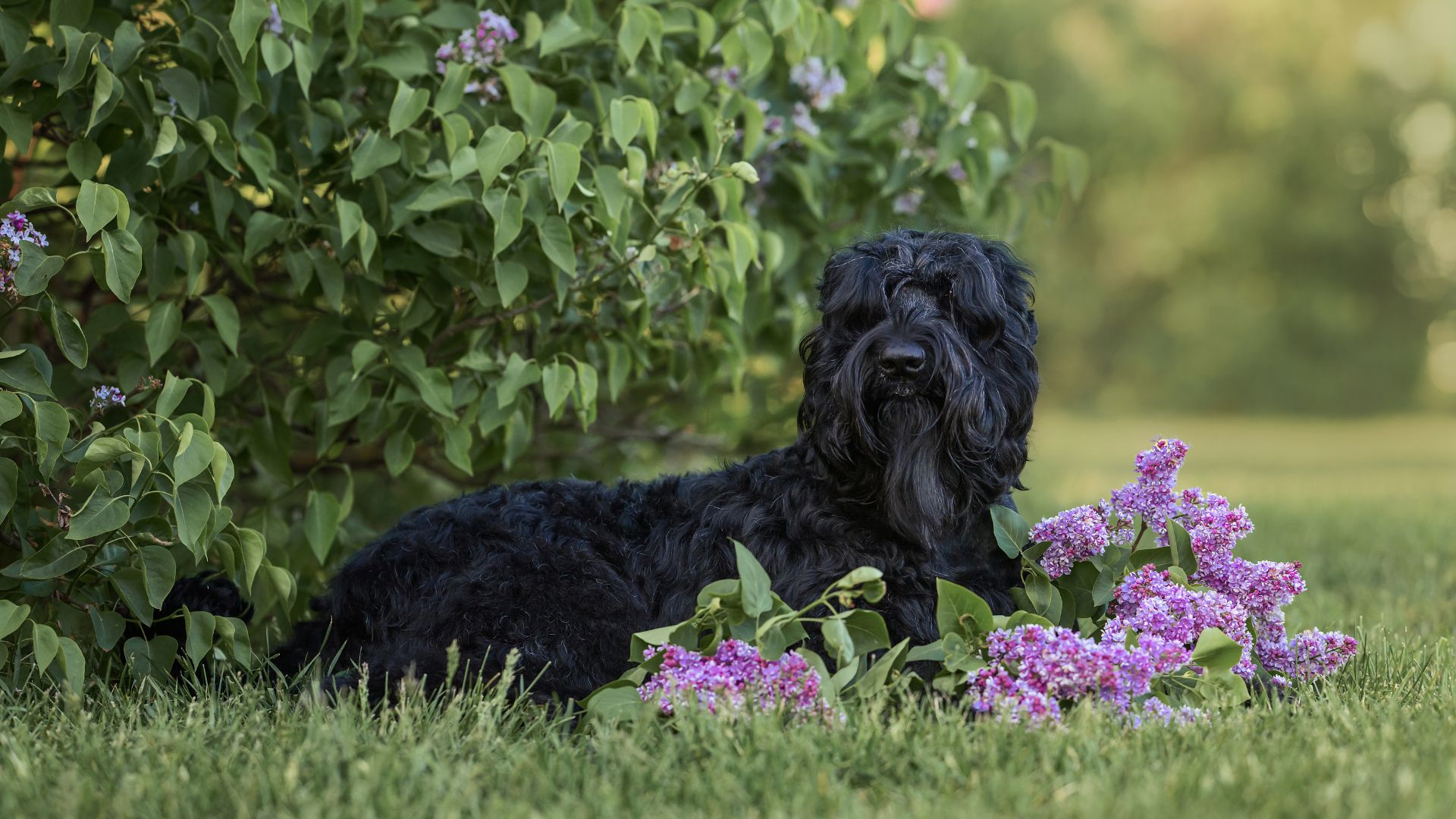There’s something magical about watching a dog roam freely and joyfully in a lush garden. While most dogs enjoy a bit of sunshine and open air, certain breeds thrive in environments where they have space to explore, dig, and play to their heart’s content. Whether it’s lounging under a shady tree or chasing butterflies between flowerbeds, some dogs are simply made for garden life.
Breeds with high energy levels or strong working instincts particularly appreciate a home with ample outdoor space. They are happiest when they can stretch their legs, engage their senses, and feel the breeze on their faces. For these dogs, a garden isn’t just a play area—it’s a space to fulfill their innate need for activity and exploration.
If you’re a dog lover with a green thumb or just someone with a spacious backyard, you’ll want to consider breeds that match your outdoor lifestyle. From digging holes to guarding the garden gate, these canine companions bring joy, energy, and purpose to any open-air setting.
Dog Breeds That Love Garden Spaces
1. Alaskan Malamute
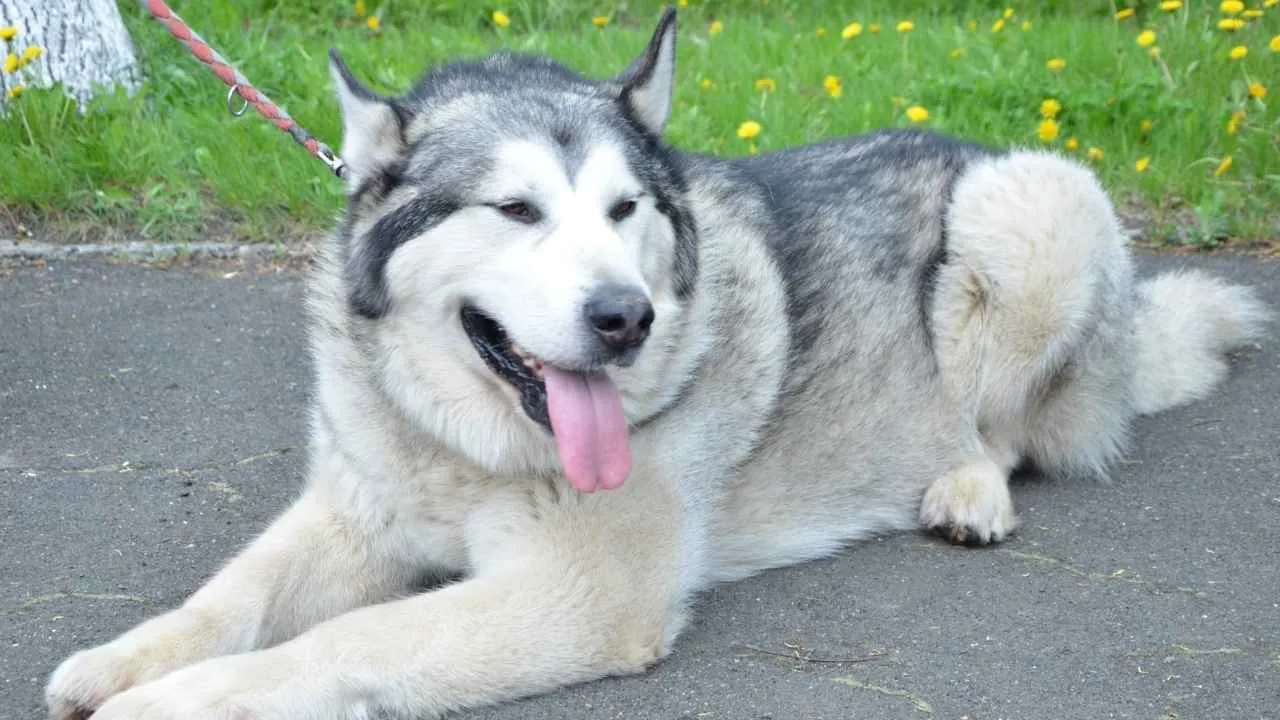
The Alaskan Malamute, also known as “Mal” or “Mally,” is a striking and powerful breed originally bred in Siberia and brought to North America via the Bering Strait. As a member of the Working Group, this thickly coated, heavy-boned dog was designed for endurance tasks such as pulling sleds across icy terrains.
Standing between 23 to 25 inches at the shoulder and weighing 75 to 85 pounds, their dense, weather-resistant coats and distinctive plumed tails offer a majestic appearance. According to Britannica, the Alaskan Malamute is a powerfully built breed, featuring a wide head and upright ears.
With a lifespan of 10 to 14 years, Mals are recognized for their confidence, loyalty, and sociable nature, making them excellent family companions. Their resemblance to Siberian Huskies often causes confusion, but the Malamute’s larger frame and dignified yet playful demeanor set it apart.
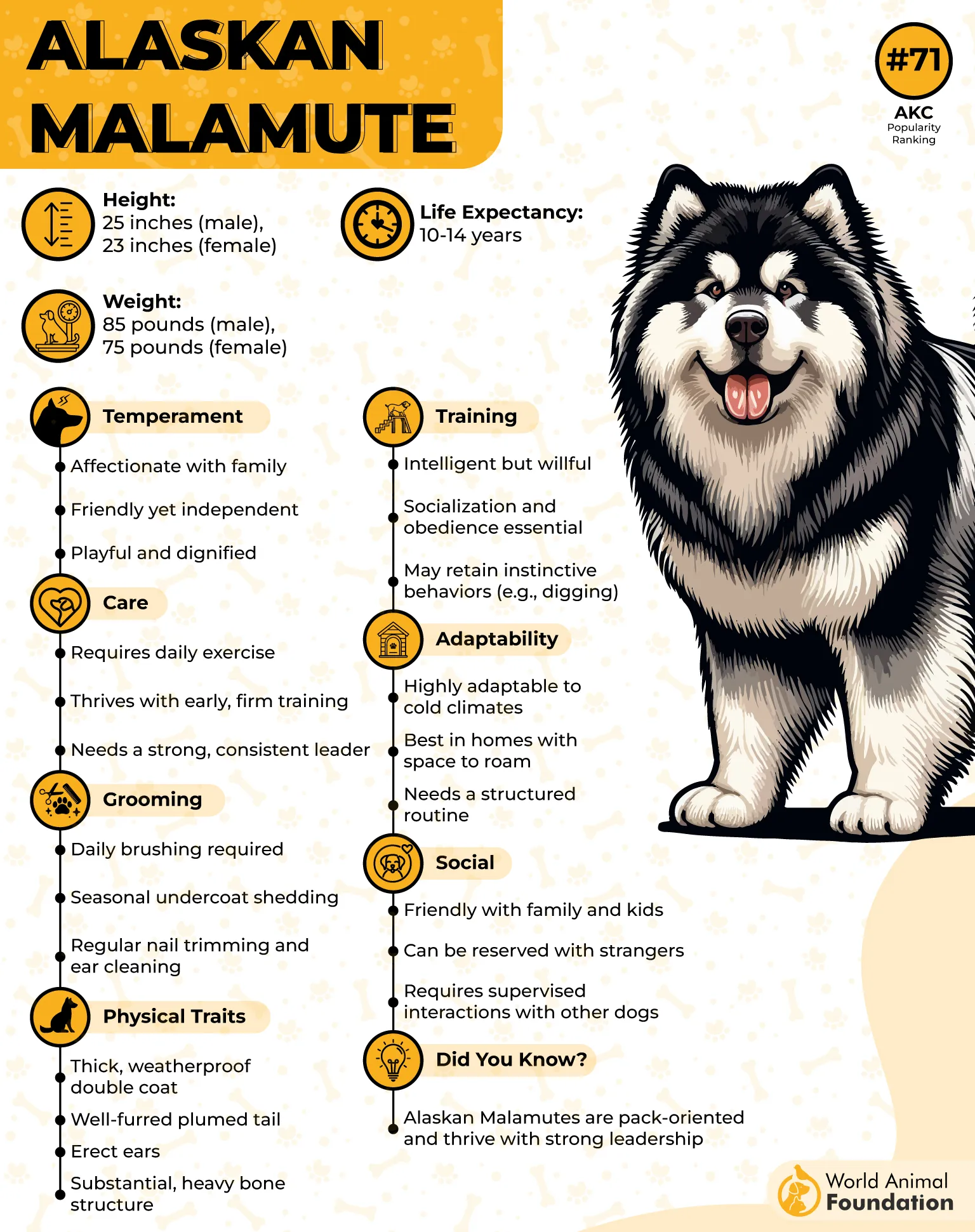
Exercise
Alaskan Malamutes thrive in homes with generous outdoor space, like a garden, where they can release their energy. These robust dogs require at least two hours of rigorous physical activity each day.
Beyond routine walks, they benefit from structured play, exploration, and opportunities to run in secure areas. Their high energy levels and natural working instincts mean a garden isn’t just appreciated—it’s essential for their well-being.
Fun Fact: Alaskan Malamutes were once used to hunt seals and deter polar bears, showcasing their remarkable strength and resilience.
2. Labrador Retriever
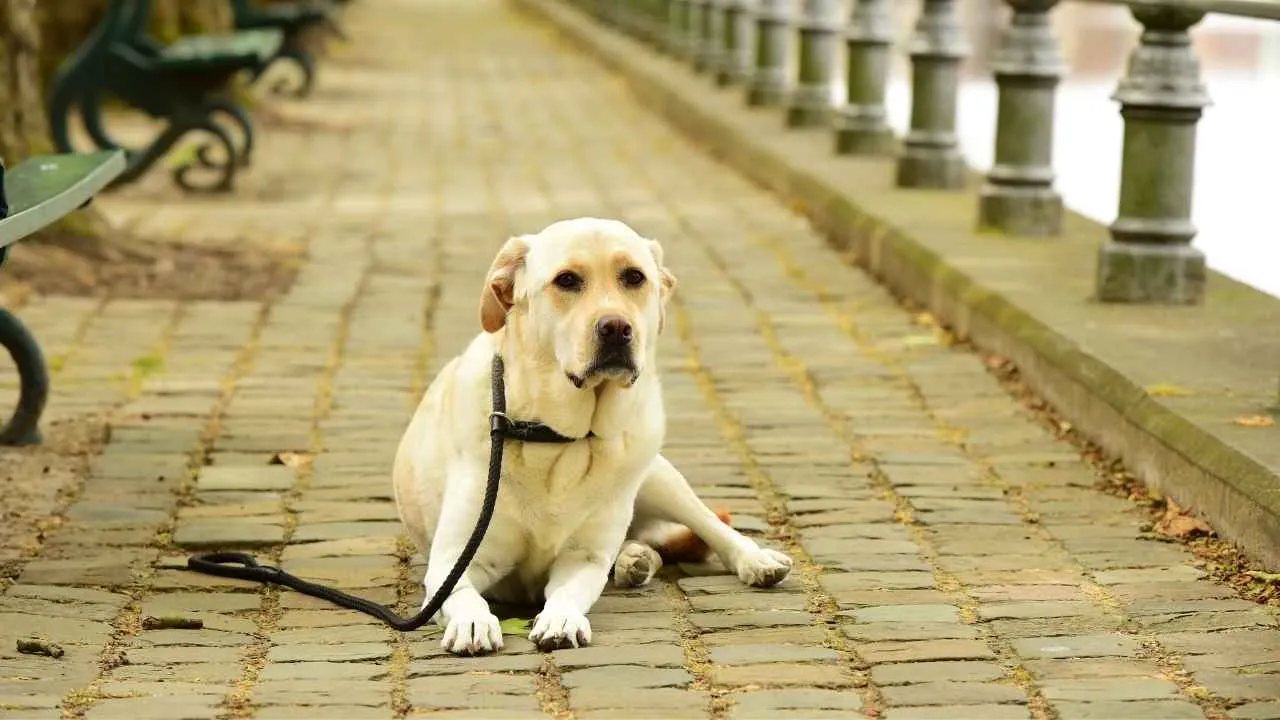
The Labrador Retriever, affectionately known as the Lab, is a medium-to-large breed beloved for its friendly nature and high-spirited personality. WebMD states that Labrador Retrievers are sociable dogs who are consistently eager to engage in play.
Originating from Newfoundland and later refined in the UK, Labs were initially bred to assist fishermen by retrieving nets and catching fish. They typically stand between 21.5 to 24.5 inches tall and weigh around 55 to 80 pounds, depending on sex.
Recognizable by their thick, water-resistant double coats—often yellow, black, or chocolate—Labs are both rugged and good-natured. Their expressive eyes and famously “otter-like” tail add to their charming appeal. As a member of the Sporting Group, the Lab is a family favorite, blending robust energy with a calm, social temperament.
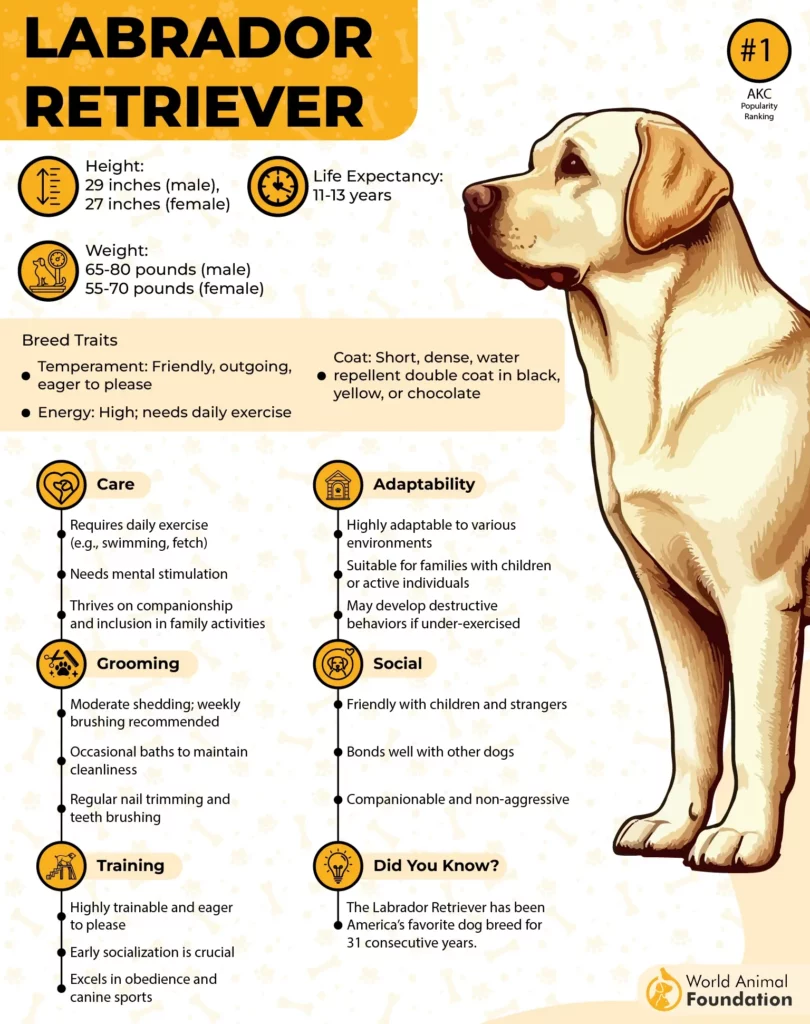
Exercise
Labs are brimming with energy and require substantial daily physical activity to remain balanced and content. A healthy adult Labrador benefits from about 2 hours of exercise each day, including walks, runs, or play in open spaces like gardens.
Their love for outdoor games like fetch or water sports makes a backyard an ideal playground. Structured activities help prevent behavioral issues and keep their agile minds stimulated.
Fact: The Lab’s waterproof double coat not only makes them excellent swimmers but also helps them enjoy rainy garden days without hesitation.
3. Border Collie
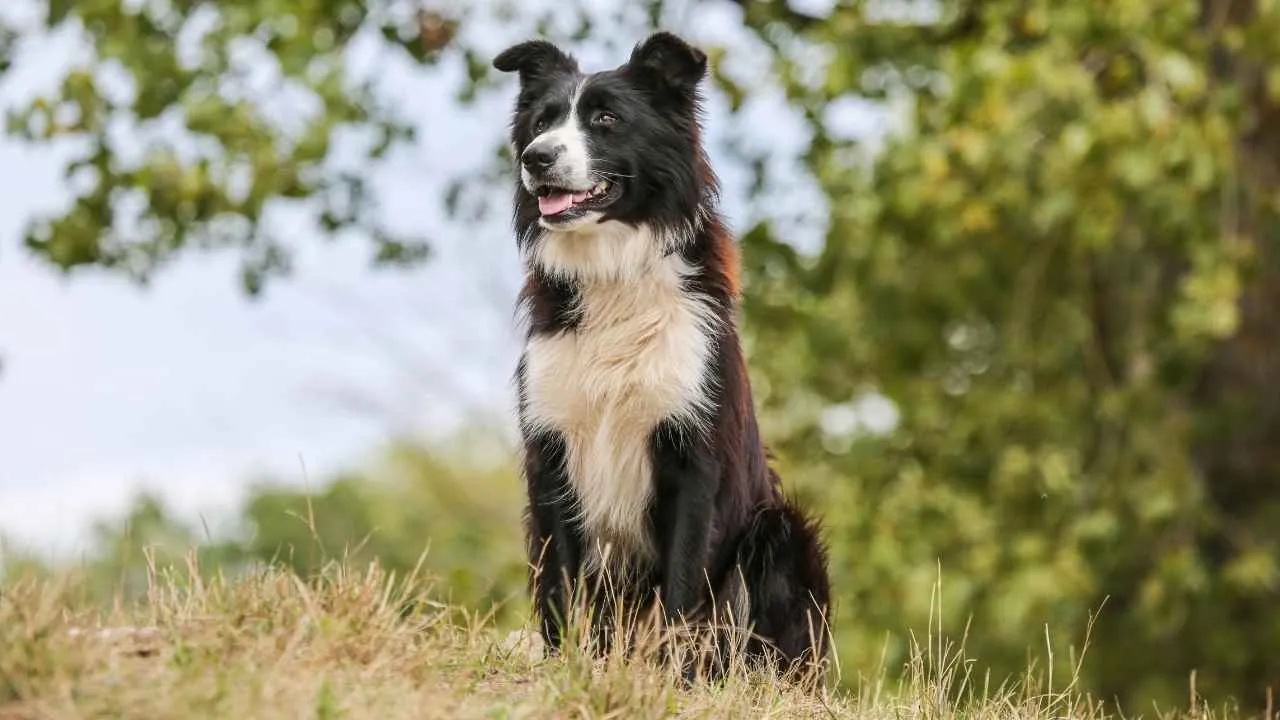
Among the most intelligent and agile dog breeds, the Border Collie is an energetic, medium-sized herding dog originally developed in the border region between Scotland and England. Recognized by their intense gaze—often referred to as the “herding eye”—and athletic build, they typically stand between 18 to 22 inches tall and weigh 30 to 45 pounds.
With a lifespan of 12 to 15 years, they belong to the Herding Group and come in both rough and smooth coat varieties, often in black and white but also merle and tricolor patterns. PetMD notes that these dogs are quick and agile, designed for swift and precise movements.
Border Collies are ideal for owners who love spending time outdoors, as these dogs crave mental and physical stimulation. Their innate problem-solving skills and high responsiveness make them excellent companions for interactive garden tasks, be it herding chickens away from delicate plants or simply keeping rabbits at bay.
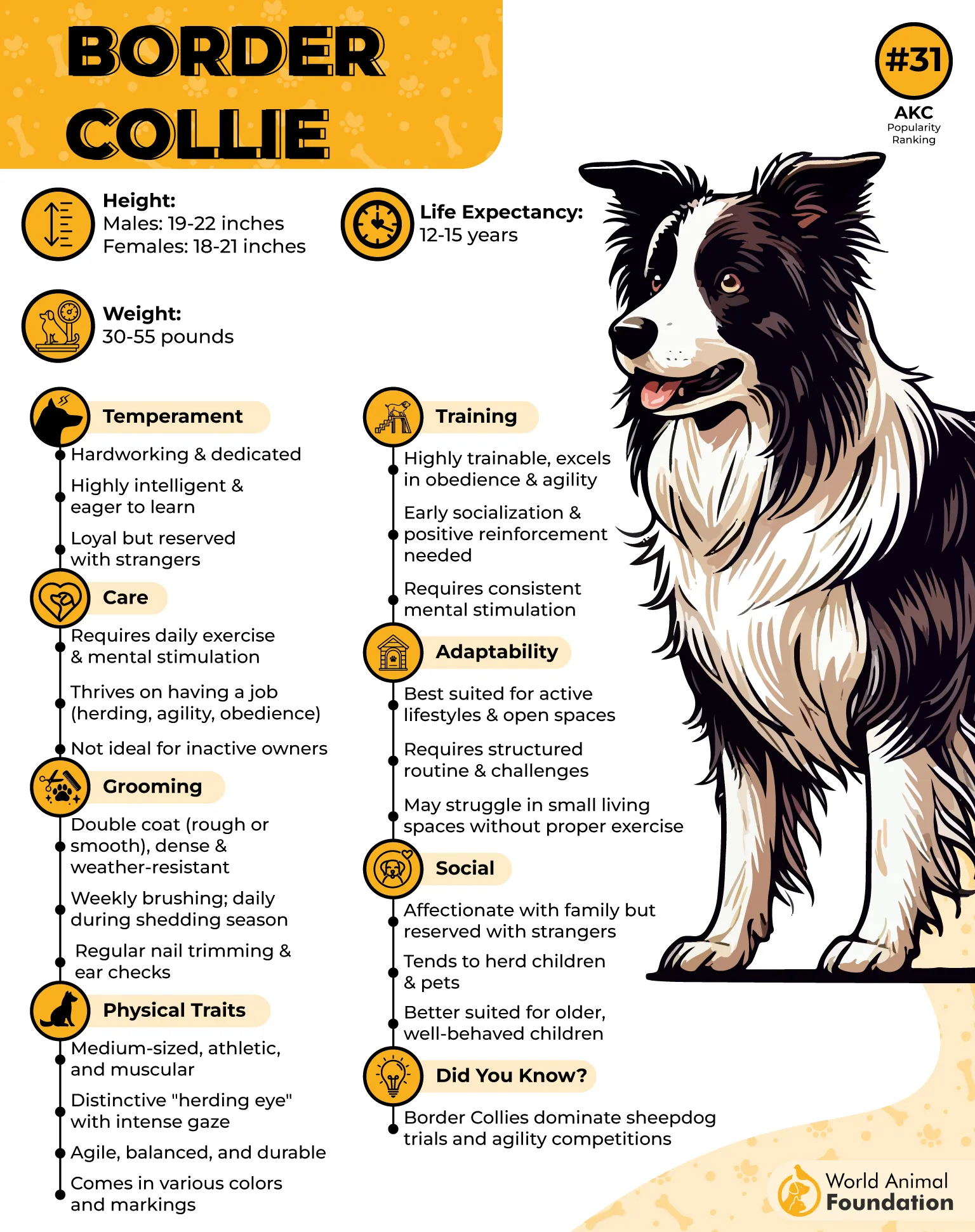
Exercise
A Border Collie requires a minimum of two hours of vigorous activity daily. Spacing walks and allowing for off-lead exercise in secure garden spaces can help meet their needs. Beyond physical exertion, they thrive on mental challenges such as treat puzzles, scent games, and obedience training.
Fact: Border Collies can be trained to assist with simple gardening tasks due to their love of having a job to do.
4. Australian Shepherd
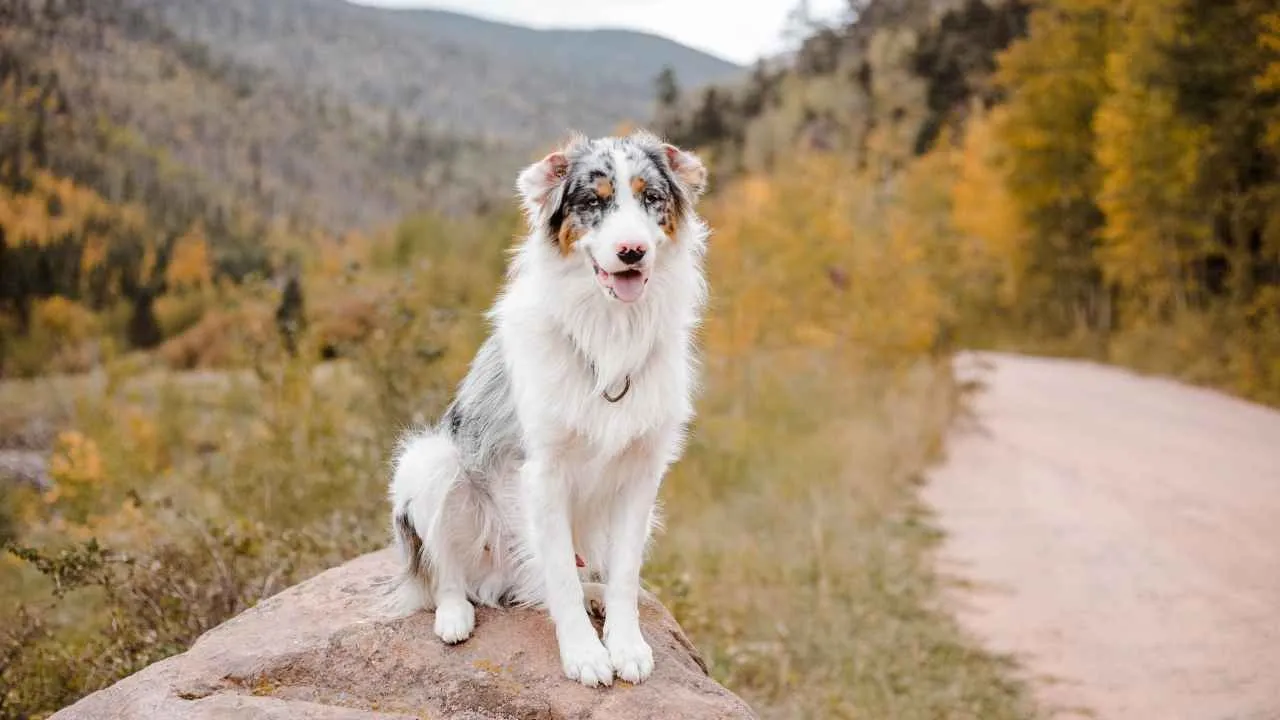
The Australian Shepherd, affectionately called the “Aussie,” is a medium-sized, athletic breed known for its boundless energy and sharp intellect. The AKC characterizes the Australian Shepherd as an intelligent and highly driven breed, known for its strong work ethic.
Though its name suggests an Australian origin, this herding dog was refined in the United States to assist ranchers and farmers. Standing around 18 to 23 inches tall and weighing between 40 and 65 pounds, the Aussie features a striking coat often in merle patterns and eyes that can be blue, brown, or even heterochromatic.
Belonging to the Herding Group, these dogs typically live between 12 to 15 years. Their expressive faces, keen gaze, and sturdy build make them both a stunning and functional addition to any home, especially those with outdoor space.
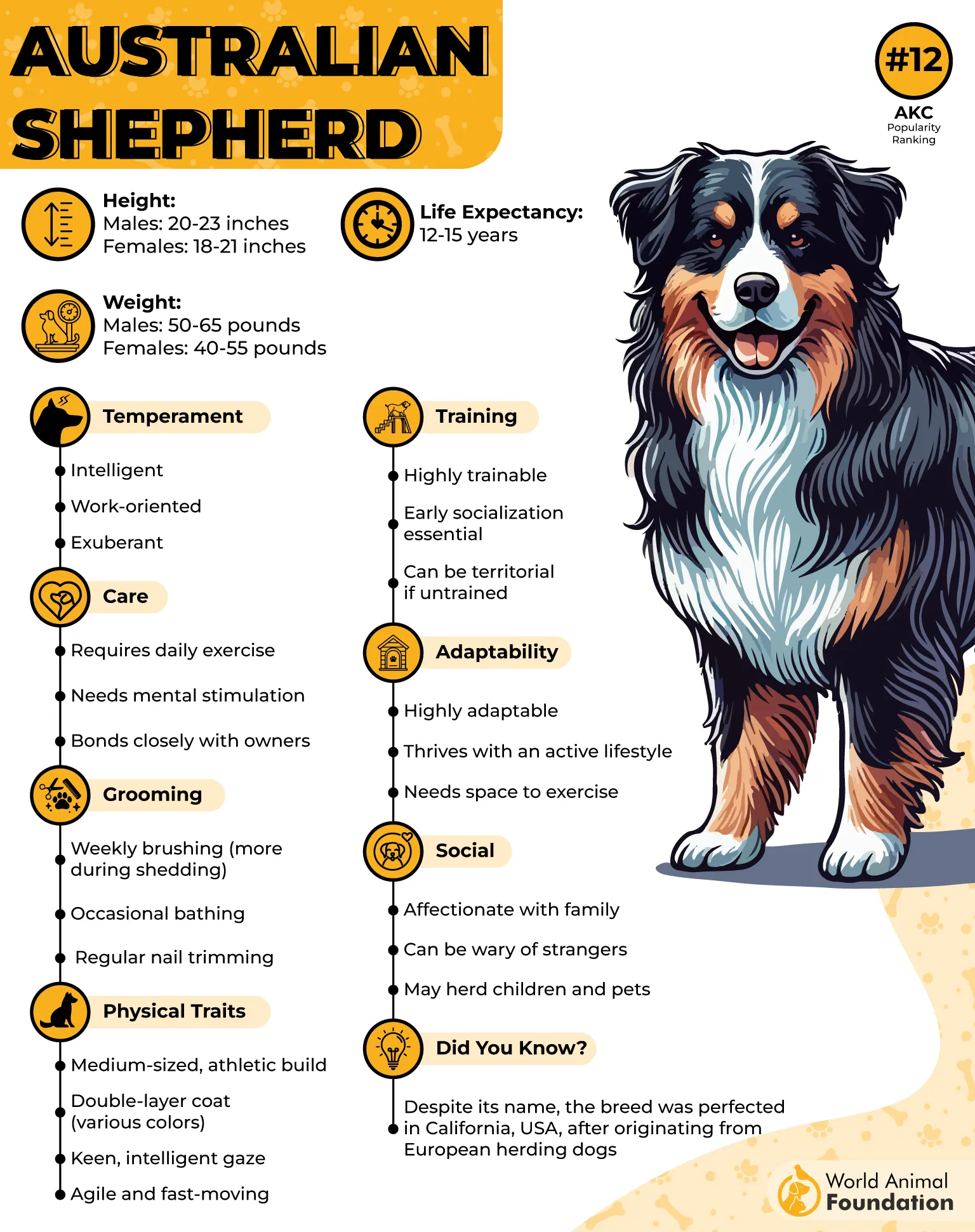
Exercise
Australian Shepherds thrive in large, secure garden spaces where they can burn off their energy. Their high stamina requires daily rigorous activity—ideally at least 1 to 2 hours of exercise involving running, fetching, or interactive play.
Aussies enjoy participating in training routines and can even help herd backyard poultry or learn garden-friendly tricks. Without enough physical and mental stimulation, they may resort to digging or herding small children or pets.
Fun Fact: Some Aussies even develop quirky habits like “herding” jet skis from the shore, showcasing their strong instincts and humorous personalities.
5. Portuguese Water Dog
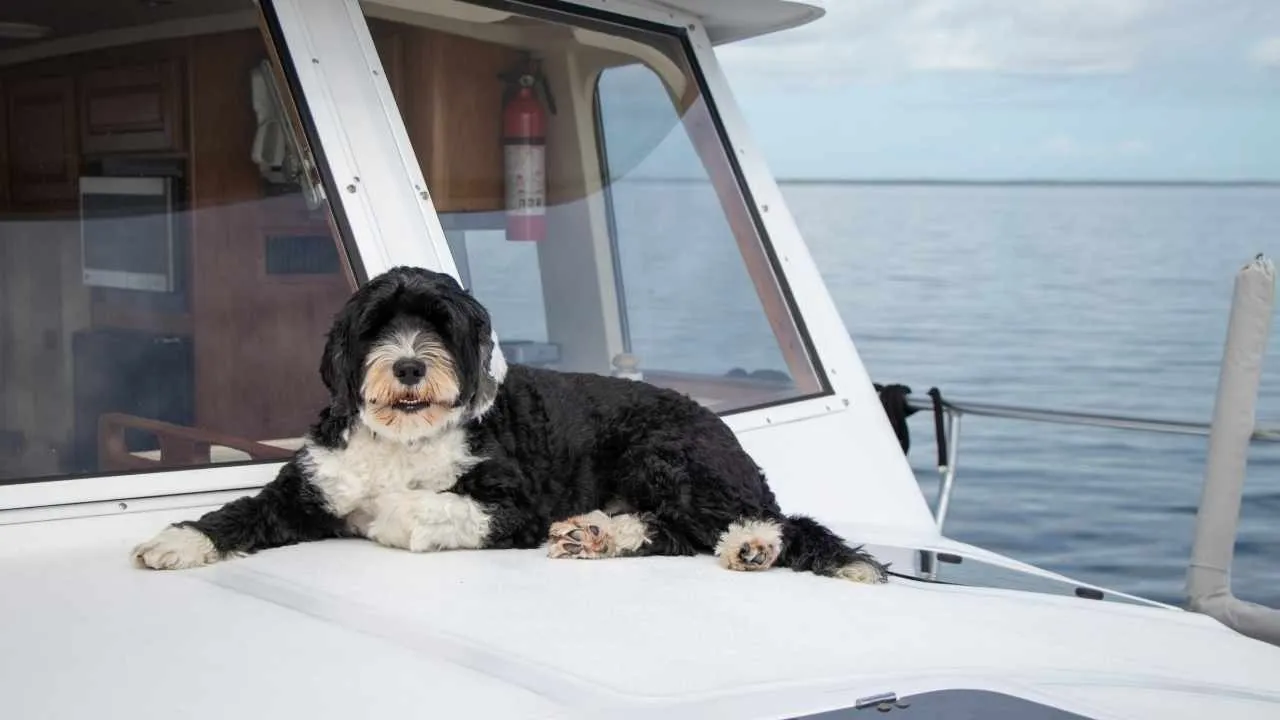
Also known as Cão de Água Português, the Portuguese Water Dog hails from Portugal’s coastal fishing villages, where it was bred to herd fish into nets, retrieve gear from the water, and even deliver messages between boats.
This medium-sized breed typically stands between 17 to 23 inches tall and weighs 35 to 60 pounds. With a robust, athletic build and a dense, curly coat that sheds minimally, they’re hypoallergenic and well-suited for active homes.
Classified under the Working Group, these dogs have a lifespan of 11 to 13 years. They’re intelligent, affectionate, and enjoy being in the center of family life, especially when that includes an engaging garden to explore.
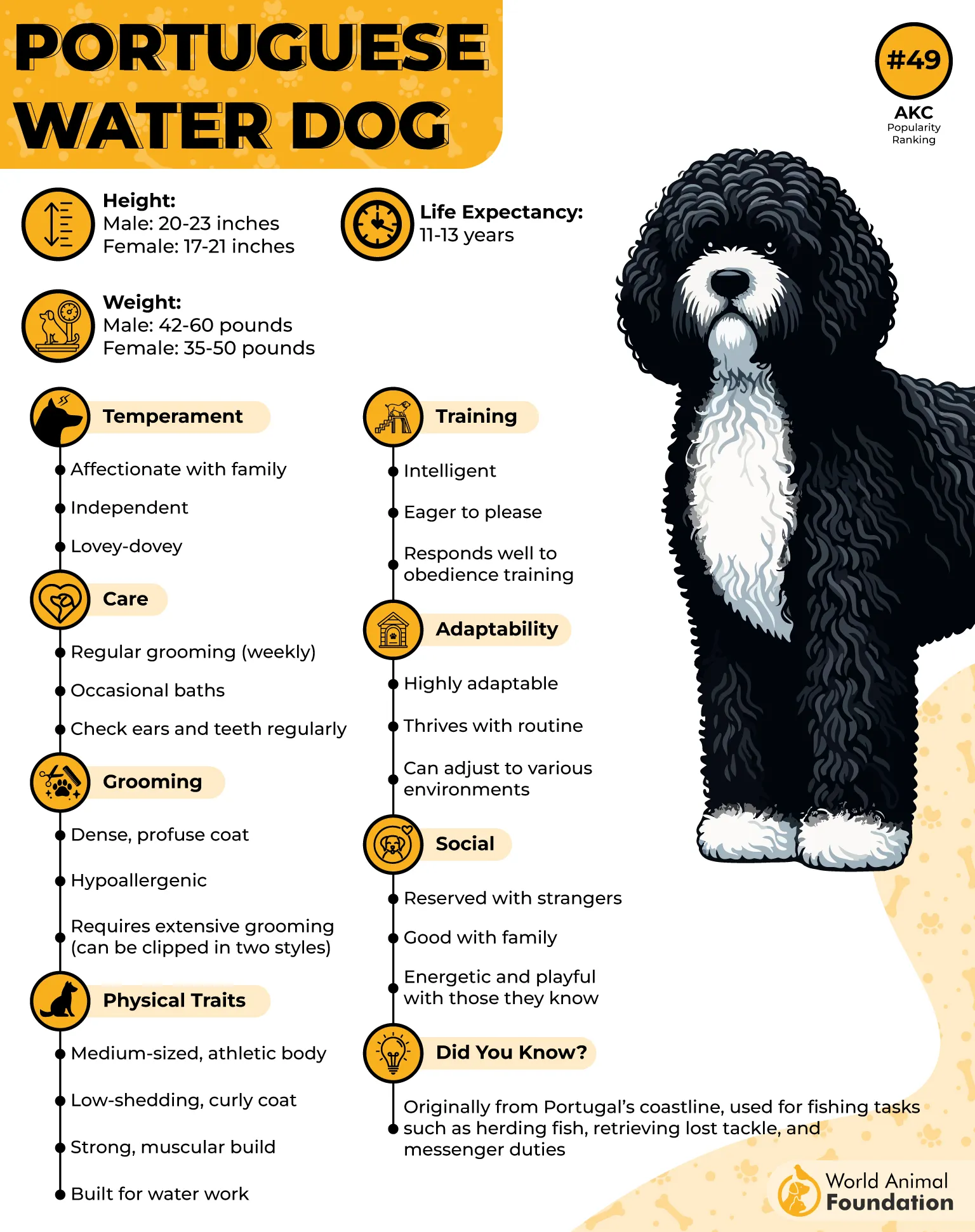
Exercise
Portuguese Water Dogs require around 30 to 60 minutes of daily exercise to maintain their mental and physical well-being. With high energy levels, they thrive on outdoor activities, including fetch, agility tasks, or even a romp through a well-secured backyard.
Gardens become their personal playgrounds, offering ample opportunities to stay stimulated and fit. Their intelligence and eagerness to learn also make them great candidates for interactive games and basic obedience sessions outside.
Fun Fact: One of the most famous Portuguese Water Dogs, Bo, belonged to former U.S. President Barack Obama and became a beloved companion in the White House.
6. Irish Wolfhound
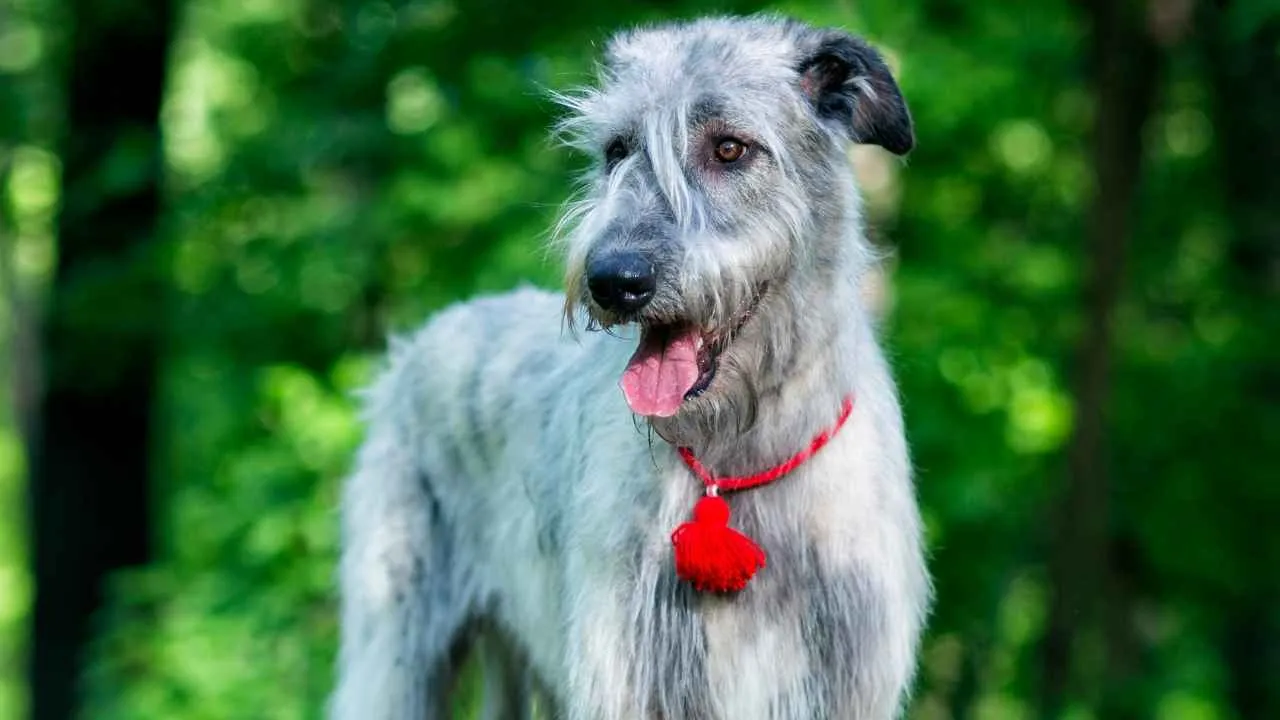
The Irish Wolfhound, often dubbed a “gentle giant,” is among the tallest of all dog breeds, with males standing close to 36 inches and weighing up to 180 pounds. Originally bred in Ireland to hunt wolves, deer, and even bears, these dogs are now beloved for their calm and kind demeanor.
Their shaggy, wiry coats come in a variety of colors, including gray, white, brindle, and black, and their powerful yet elegant build reflects their Greyhound ancestry. Classified under the Hound Group, they are known for their strength, grace, and quiet nature.
Despite their immense size, Irish Wolfhounds are remarkably gentle and affectionate, making them ideal for spacious homes with large gardens. These dogs prefer the tranquility of nature and benefit from having outdoor areas to lounge and roam safely.
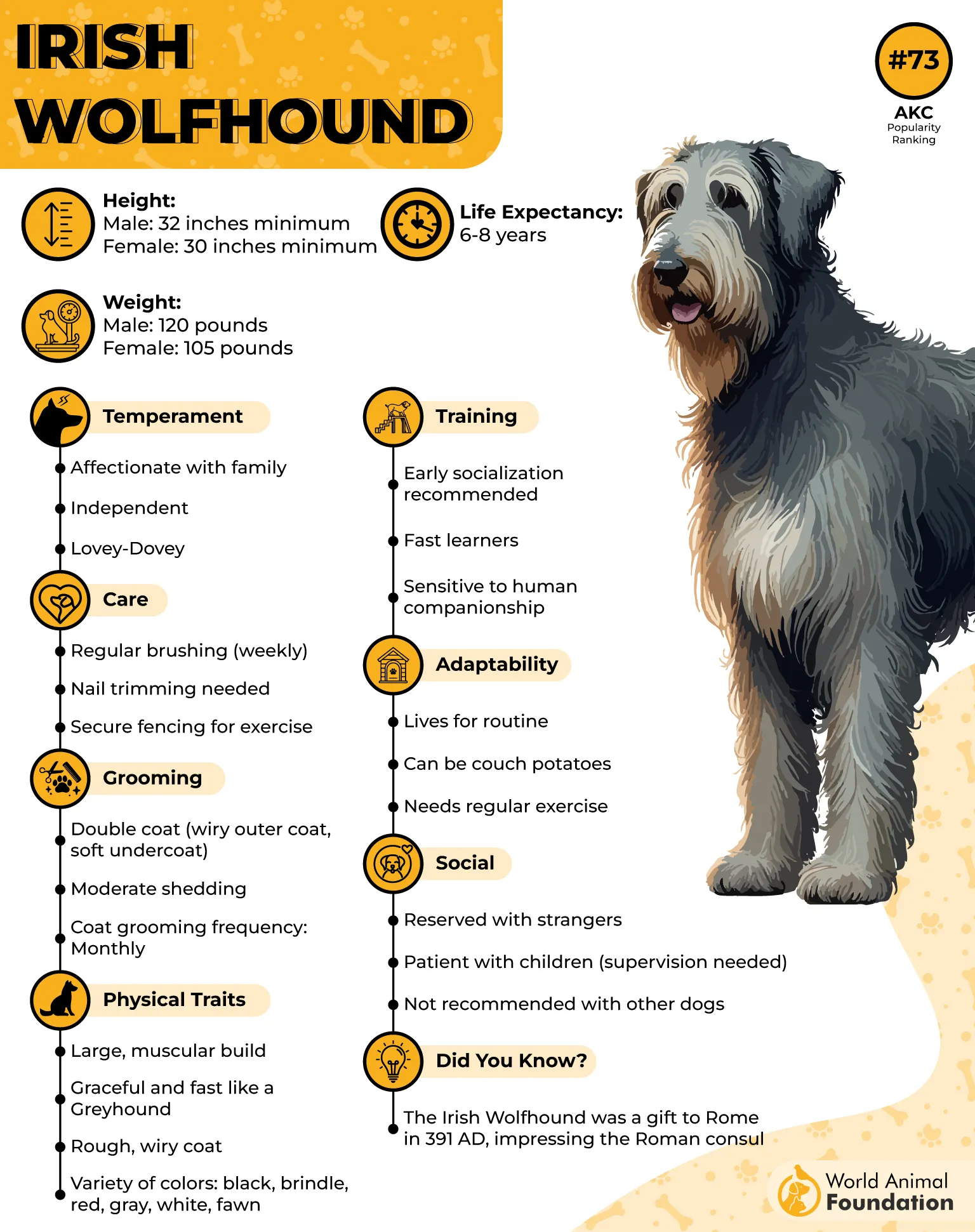
Exercise
This breed thrives with at least two hours of exercise daily, best divided throughout the day. While they appear laid-back indoors, their athletic background means they require both walks and secure off-lead play in expansive spaces.
A fenced garden is ideal for safe roaming, as tie-outs are ineffective due to their size and power. These dogs enjoy spending time outdoors, but they should never be housed outside full-time.
Fun Fact: Historically, Irish Wolfhounds were so formidable that they were used in battle to pull soldiers off horses.
7. Golden Retriever
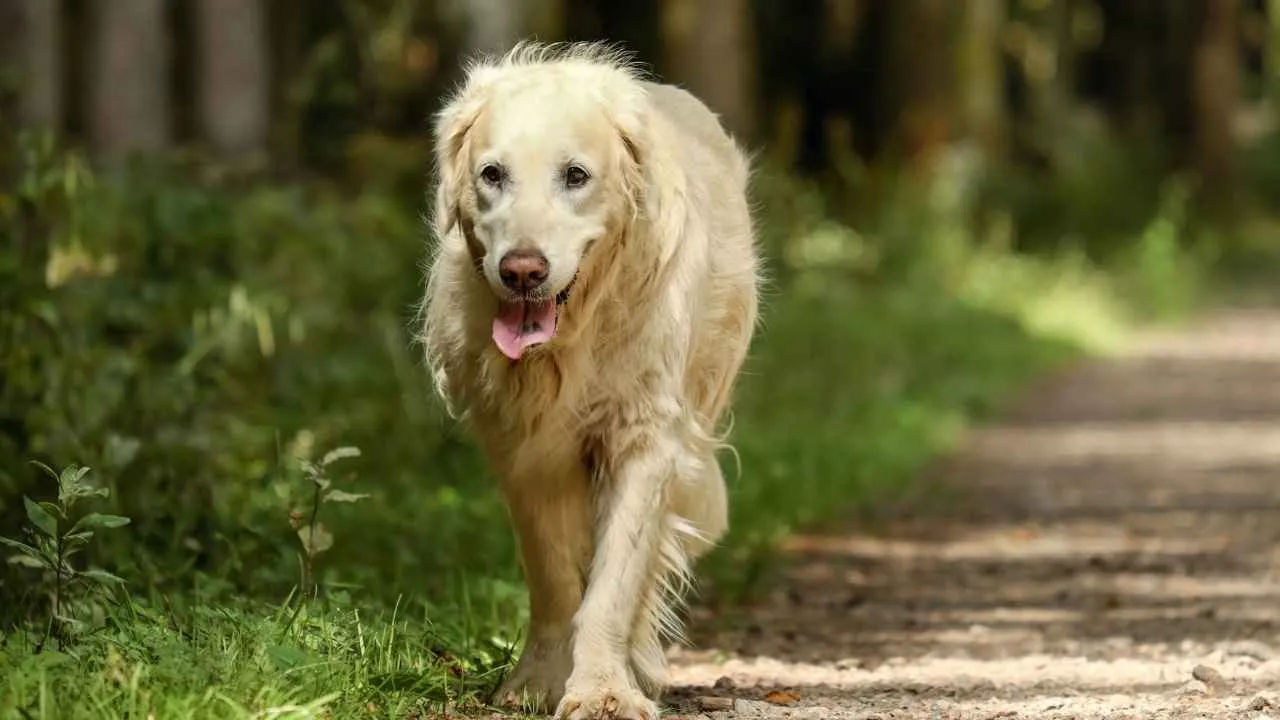
The Golden Retriever is a Scottish gundog breed renowned for its loyalty, intelligence, and endearing temperament. Originally developed in the 19th century at the Guisachan estate in Inverness-Shire, Scotland, these dogs were bred to retrieve game on land and water.
Standing between 21.5 to 24 inches tall and weighing 55 to 75 pounds, Golden Retrievers possess a dense, water-repellent golden coat, a broad, friendly face, and a joyful, feathery tail often seen wagging in delight.
They belong to the Sporting Group and typically live 10 to 12 years. Their affable and social nature makes them ideal for families, and their patience suits gardens bustling with children or visitors.
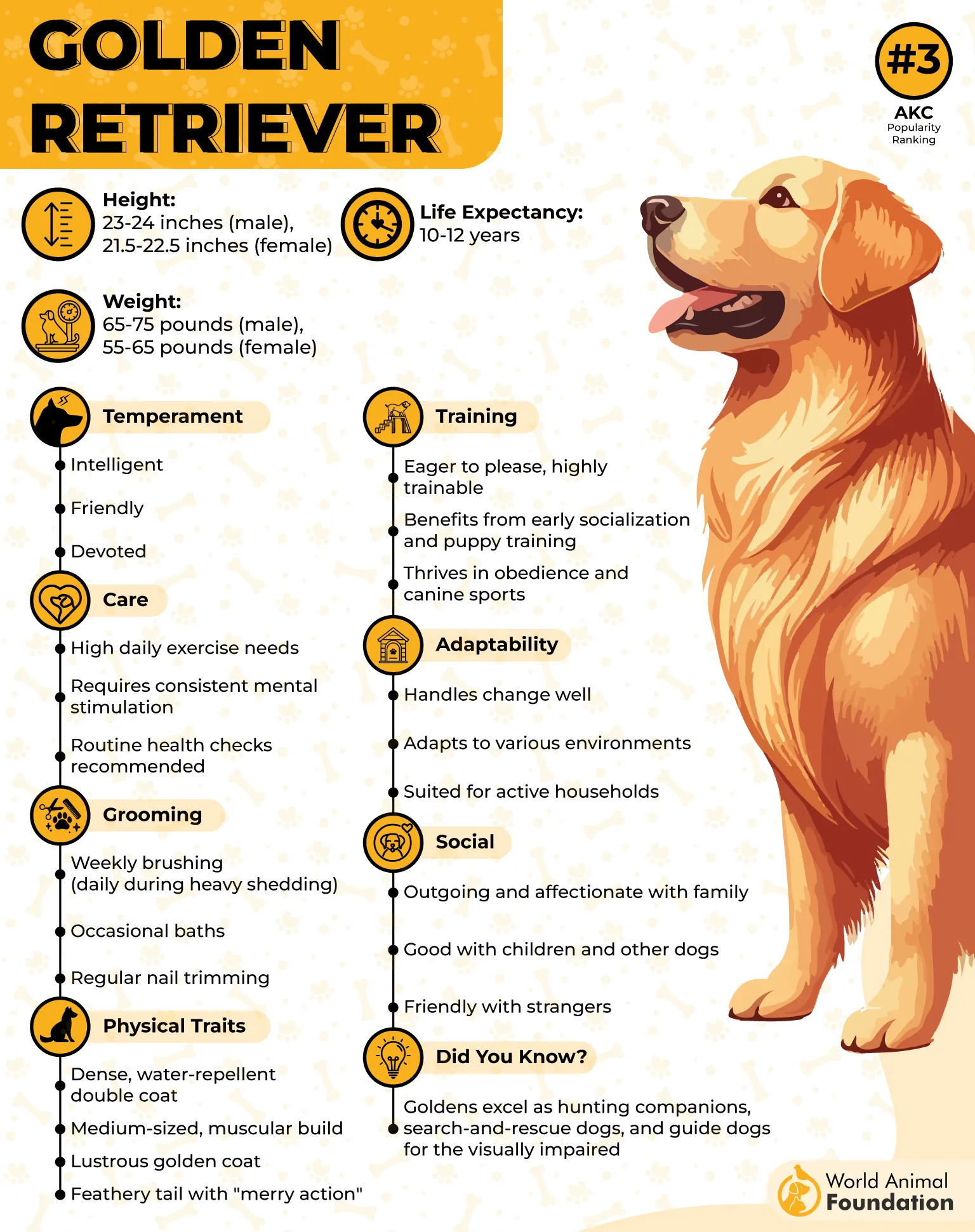
Exercise
Golden Retrievers thrive in outdoor environments, especially garden spaces where they can run freely. They require a minimum of two hours of daily exercise, ideally split across the day. Activities like walking, running, swimming, and engaging in play sessions help satisfy their energetic nature.
Games like fetch and hide-and-seek are great ways to keep them mentally stimulated while exploring garden nooks. Their natural retrieving instincts also make interactive playtime a bonding and fulfilling experience.
Fun Fact: Golden Retrievers have a soft mouth, allowing them to carry delicate objects—like a garden glove—without damaging them.
8. German Shepherd
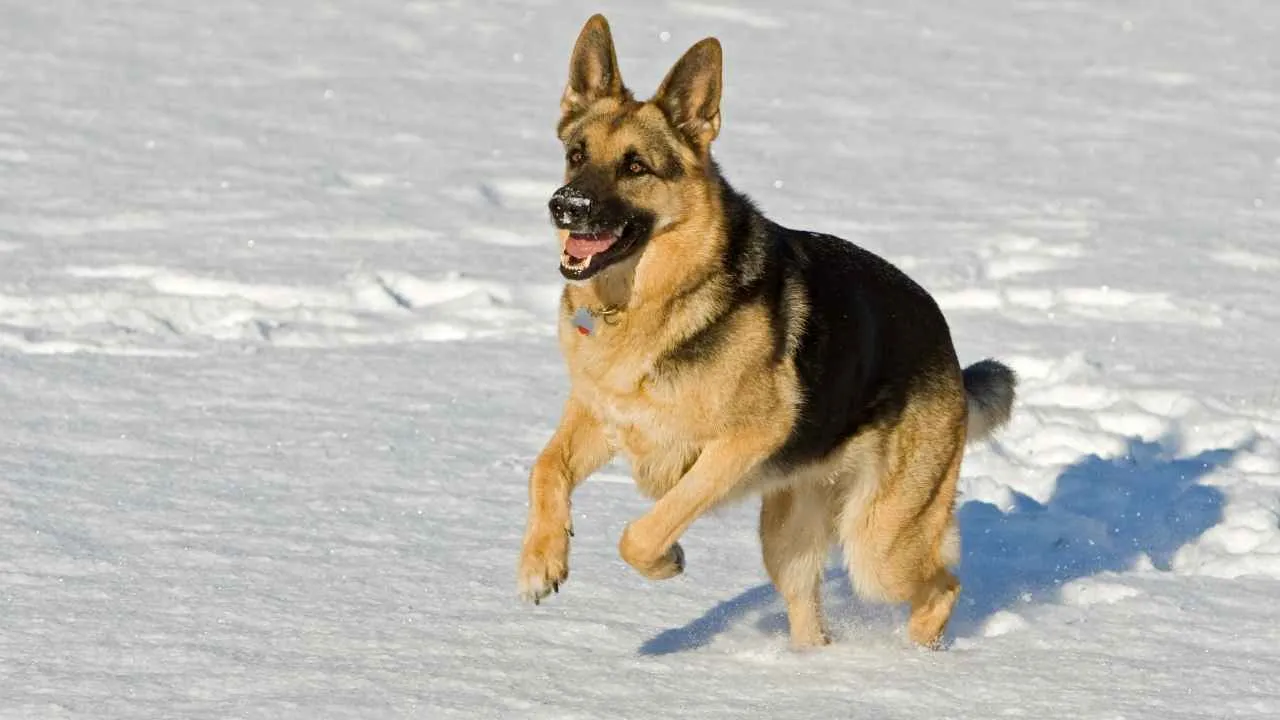
The German Shepherd, also known as the Alsatian, is a large, highly intelligent, and agile breed originally developed in Germany as a herding dog. Standing up to 26 inches tall and weighing between 50 to 90 pounds, this noble and versatile breed belongs to the herding group and typically enjoys a lifespan of 9 to 13 years.
Known for their iconic black-and-tan coat and confident demeanor, German Shepherds are widely recognized for their loyalty, alertness, and trainability.
Their physical strength and mental sharpness make them popular choices for police work, protection, and companionship. These dogs thrive in open spaces and make excellent garden-loving companions due to their natural curiosity and desire to patrol and explore.
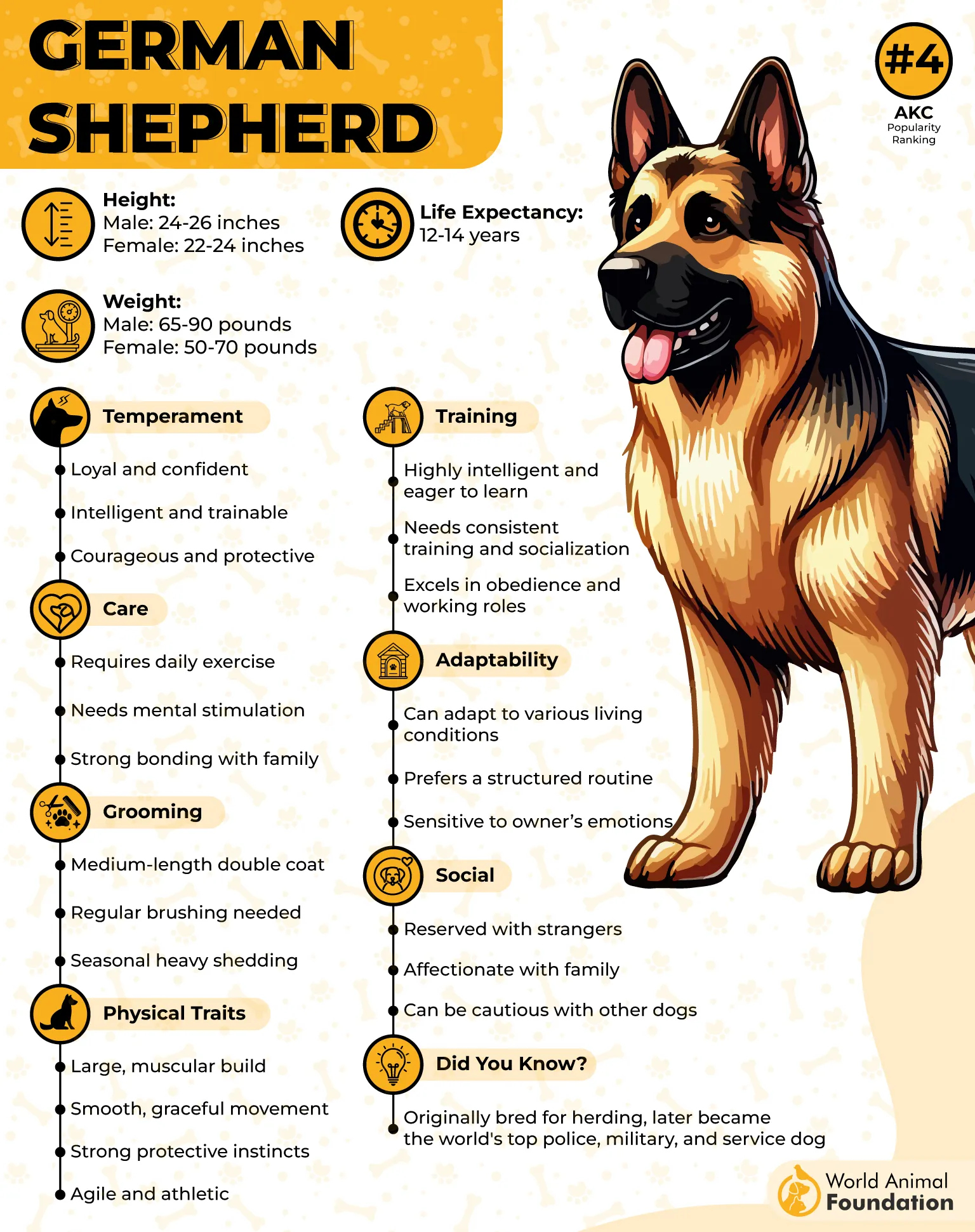
Exercise
German Shepherds are highly active and require at least one to two hours of daily exercise. Ideal routines go beyond walks, including running, hiking, scent games, and agility training to satisfy their mental and physical needs.
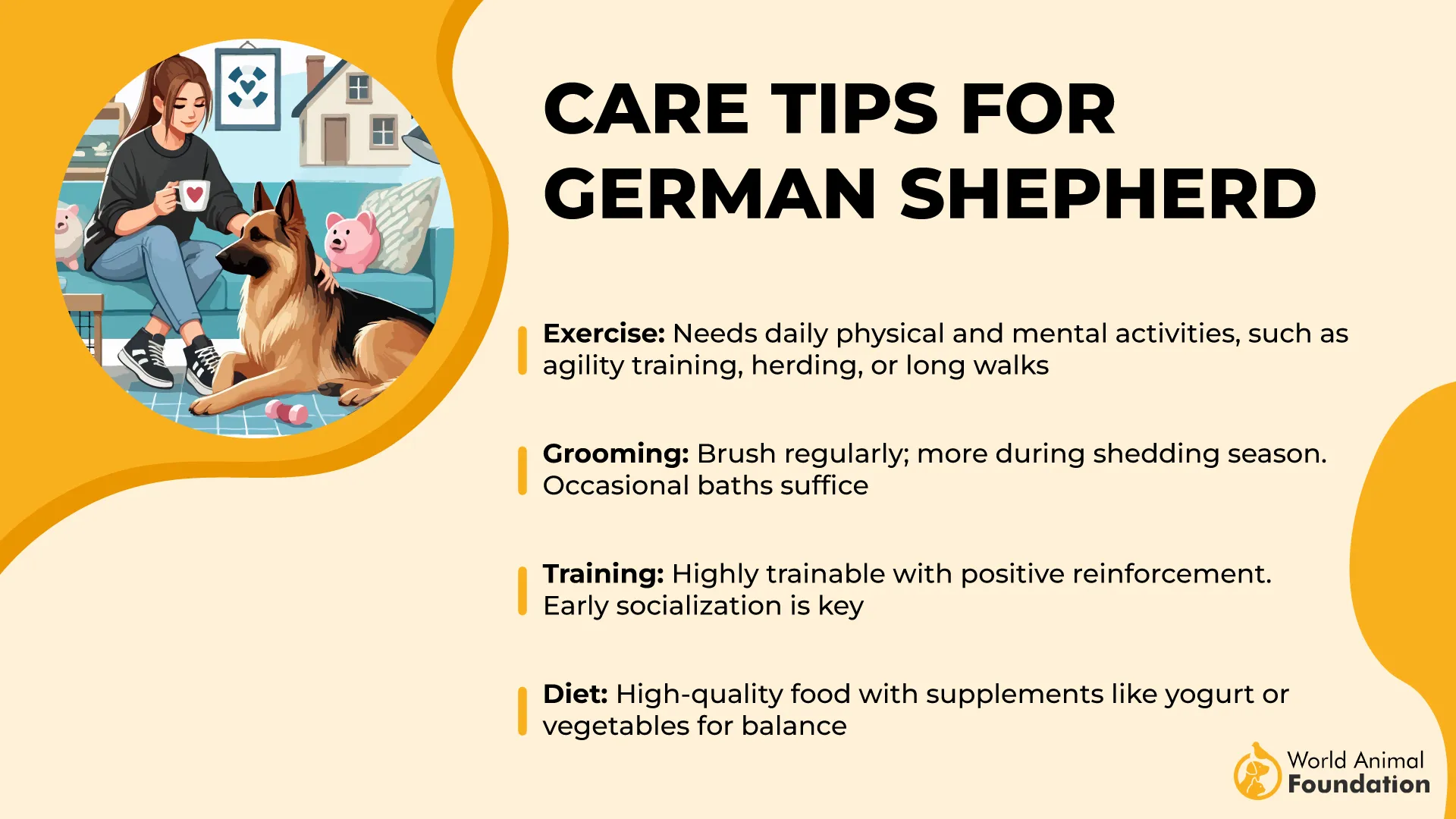
Without sufficient stimulation, they can develop destructive behaviors. A garden provides the perfect environment for enrichment activities and space to roam freely.
Fun fact: Despite their size and strength, German Shepherds are known for their grace and naturally fluid gait, allowing them to trot effortlessly for long periods.
9. Vizsla
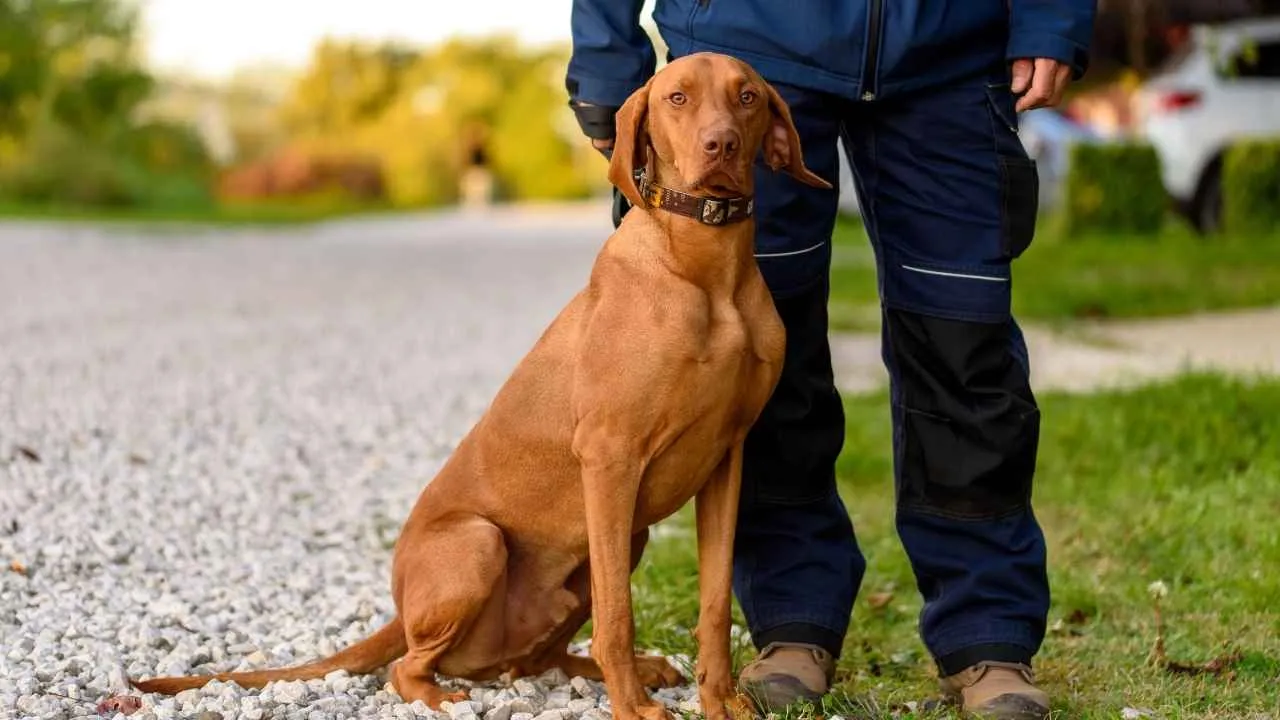
Graceful, loyal, and brimming with energy, the Vizsla is a medium-sized sporting breed from Hungary, revered for its versatility as a hunter and companion. Known also as the Hungarian Pointer, this sleek, rust-colored dog is admired for its lean musculature, deep chest, and expressive almond-shaped eyes that blend with its coat.
Males typically stand between 22 to 24 inches and weigh 55 to 60 pounds, while females are slightly smaller. Initially bred by Magyar tribes for retrieving game over land and water, the Vizsla nearly disappeared during the World Wars but was later revived by breed enthusiasts. Today, it belongs to the Sporting Group and lives an average of 12 to 14 years.
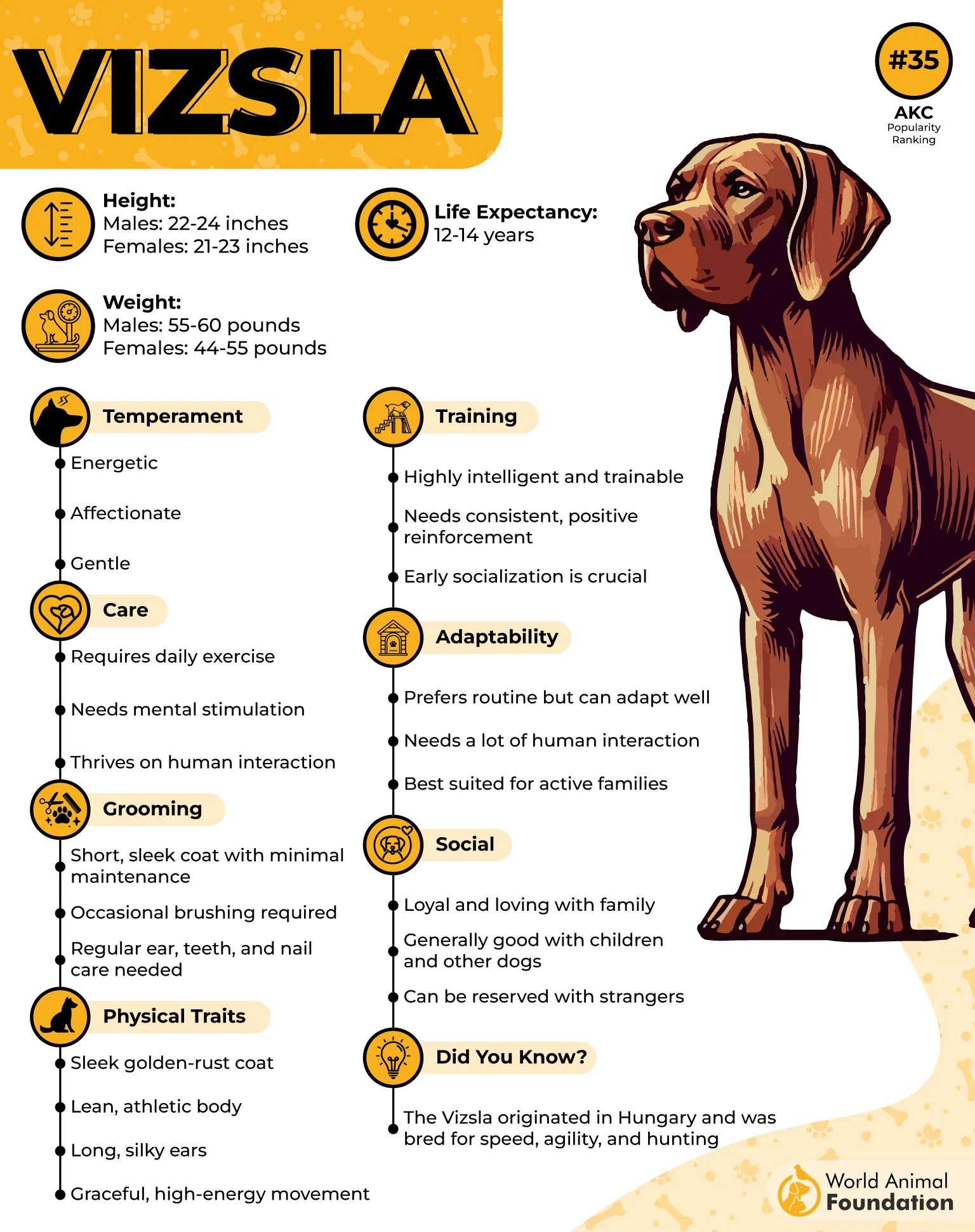
Exercise
These loyal dogs are exceptionally active dogs that require both physical exertion and mental stimulation to remain content. A minimum of 1.5 to 2 hours of daily activity—such as running, hiking, agility sports, or structured games like fetch—is ideal.
Their high endurance and love for the outdoors make them thrive in homes with access to large gardens or open play spaces. Inadequate exercise can lead to behavioral problems due to boredom or anxiety.
Fun Fact: The Vizsla is often nicknamed the “Velcro dog” for its strong attachment to its owner and its constant desire to be close.
10. Siberian Husky
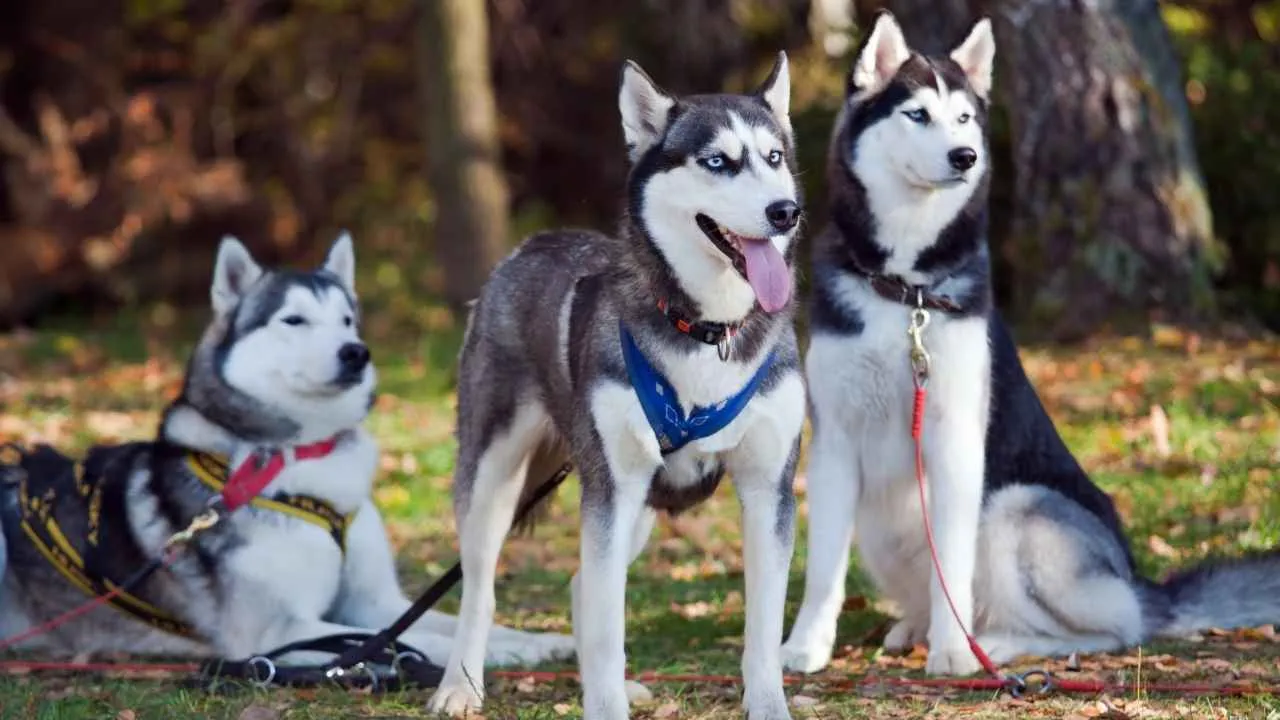
Recognized for their striking wolf-like appearance and intense blue or bi-colored eyes, the Siberian Husky is a medium-sized working breed from northeastern Siberia. Known as the “Sibe,” this breed was originally developed to pull sleds across frozen landscapes in packs at moderate speeds.
With a height ranging from 20 to 23.5 inches and weighing up to 60 pounds, Huskies boast a dense double coat that insulates them in both cold and warm climates. They belong to the Working Group and typically live between 12 to 14 years.
Their graceful and athletic movement is complemented by a naturally clean coat and a friendly, sociable temperament that makes them beloved companions. Though not natural watchdogs due to their friendliness, they can be expressive and vocal, often howling rather than barking.
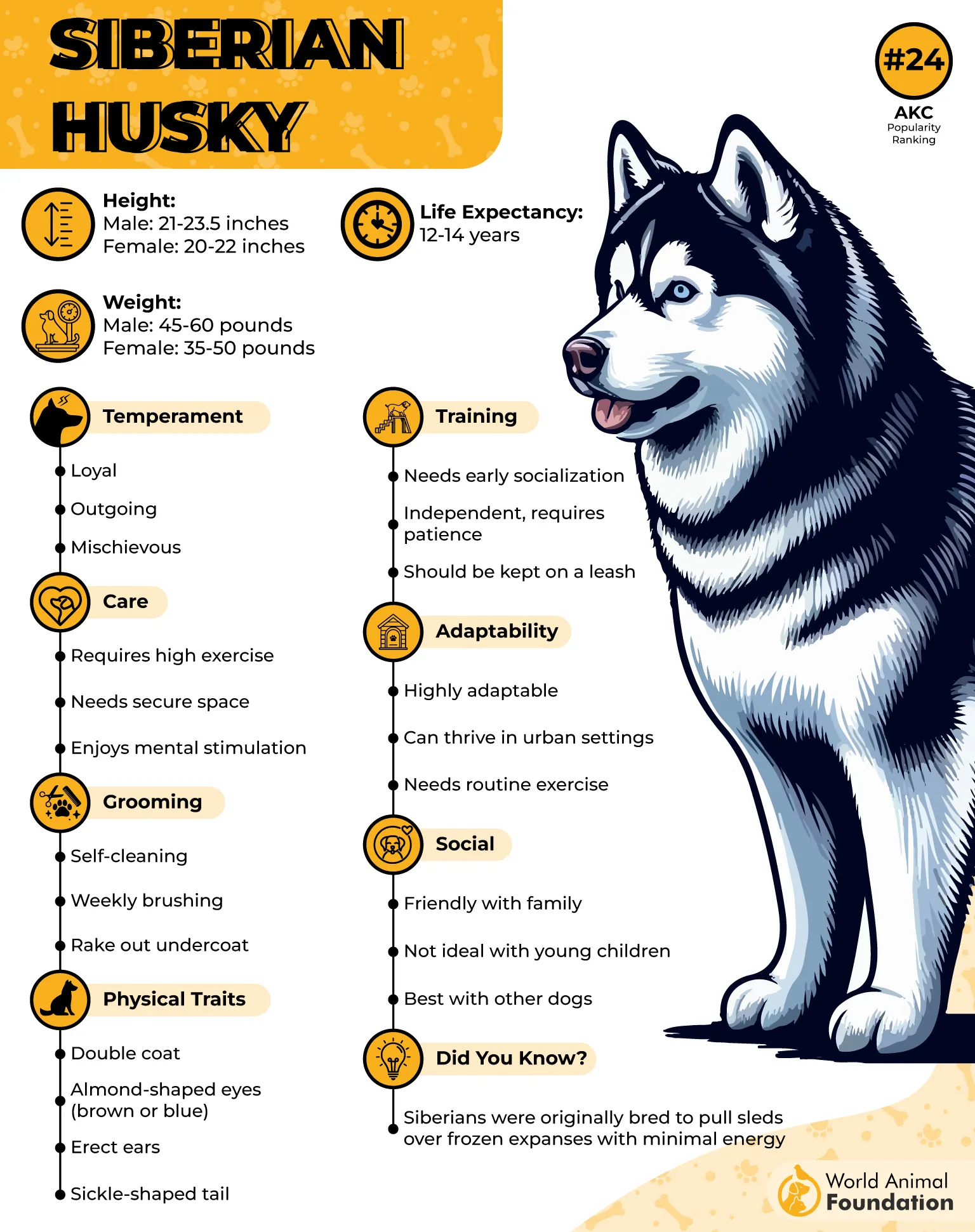
Exercise
True to their sled-pulling heritage, Siberian Huskies are incredibly active and thrive in environments that provide space to roam. They require at least two hours of vigorous daily exercise, ideally through activities like running, hiking, or agility training.
A spacious garden offers an ideal setup for these high-energy dogs to burn off steam, explore, and stay mentally stimulated. However, secure fencing is essential—they are notorious escape artists and love to chase after small animals.
Fun Fact: Siberian Huskies are known for being naturally clean dogs with minimal odor and fastidious grooming habits.
Conclusion
If you have a spacious yard or enjoy outdoor adventures, choosing the right dog breed that thrives in such an environment is essential. Many pups, like Australian Cattle Dogs or Great Pyrenees, not only enjoy their own space but also flourish with the freedom a garden provides. Whether it’s the energetic playfulness of a puppy or a mature pup’s need for mental stimulation, these outdoor-loving breeds benefit greatly from having their own backyard. It also helps curb issues like separation anxiety by keeping them engaged and active when you’re away.
Most breeds with a strong prey drive or guard dog instincts, such as Bernese Mountain Dogs and American Foxhounds, also appreciate environments where they can stay outdoors safely. For households with a cat or other pets, it’s important to supervise interactions and ensure each animal gets enough exercise. Ultimately, the best outdoor dog is one that aligns with your lifestyle and makes the most of your outdoor space with loyalty, energy, and joy.


